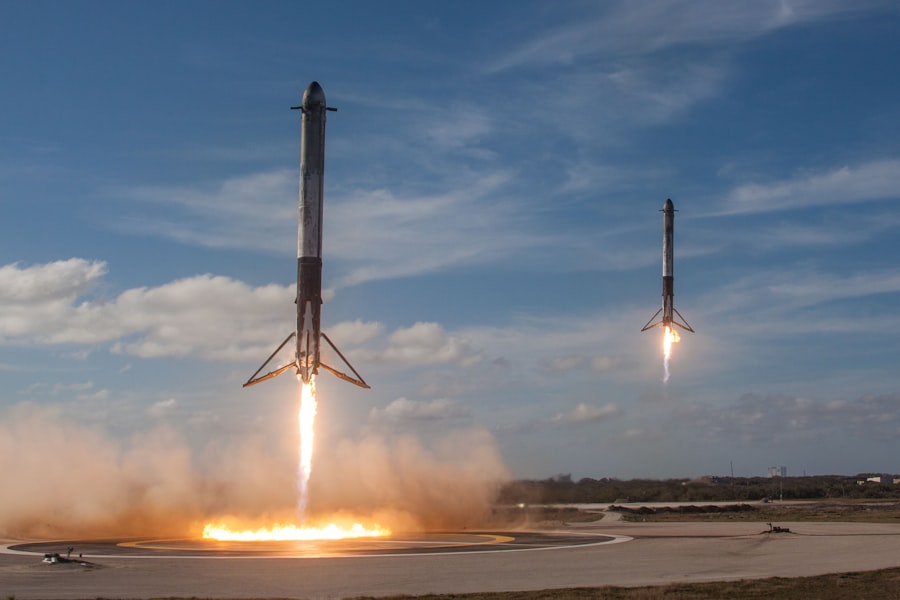Aerospace technology encompasses a broad spectrum of engineering disciplines and scientific principles that are essential for the design, development, and operation of aircraft and spacecraft. This field integrates various technologies, including aerodynamics, propulsion, avionics, materials science, and systems engineering, to create vehicles capable of navigating through the Earth’s atmosphere and beyond. The significance of aerospace technology extends beyond mere transportation; it plays a crucial role in national defense, global communication, environmental monitoring, and even space exploration.
As the world becomes increasingly interconnected, advancements in aerospace technology are pivotal in addressing contemporary challenges such as climate change, resource management, and international security. The evolution of aerospace technology has been marked by remarkable achievements that have transformed how humanity interacts with the skies and outer space. From the Wright brothers’ first powered flight in 1903 to the sophisticated spacecraft that explore distant planets today, the journey has been one of innovation and discovery.
The field is characterized by its rapid pace of development, driven by both commercial interests and governmental initiatives. As we delve deeper into the history and advancements of aerospace technology, it becomes evident that this domain is not only about engineering feats but also about the vision and ambition to push the boundaries of what is possible.
Key Takeaways
- Aerospace technology has evolved significantly, shaping modern transportation and defense.
- Historical advancements laid the foundation for current aerospace innovations.
- Continuous improvements in aerospace technology are crucial for safety, efficiency, and exploration.
- Parker Hannifin plays a key role in developing cutting-edge aerospace components and systems.
- Future aerospace technology promises enhanced capabilities with broad societal benefits.
History of Aerospace Technology
The history of aerospace technology can be traced back to ancient civilizations that dreamed of flight. Early attempts at human flight included the use of kites in China and the development of hot air balloons in the 18th century. However, it was not until the early 20th century that significant progress was made with the advent of powered flight.
The Wright brothers’ successful flight at Kitty Hawk in 1903 marked a pivotal moment in aviation history, demonstrating that controlled flight was achievable. This breakthrough laid the groundwork for subsequent developments in aircraft design and engineering. Following World War I, advancements in aerospace technology accelerated rapidly due to military needs and competition among nations.
The introduction of metal airframes, more powerful engines, and advanced aerodynamic designs led to faster and more efficient aircraft. The interwar period saw the emergence of commercial aviation, with airlines beginning to offer passenger services. The onset of World War II further propelled aerospace technology forward, as nations invested heavily in research and development to gain aerial superiority.
Innovations such as radar, jet propulsion, and pressurized cabins emerged during this time, setting the stage for the modern aviation industry.
Importance of Advancements in Aerospace Technology

Advancements in aerospace technology are critical for several reasons, primarily due to their impact on safety, efficiency, and environmental sustainability. As air travel becomes increasingly accessible to the global population, ensuring the safety of passengers is paramount. Innovations such as advanced avionics systems, improved navigation technologies, and enhanced materials have significantly reduced the likelihood of accidents.
For instance, modern aircraft are equipped with sophisticated autopilot systems that can handle complex flight operations, allowing pilots to focus on critical decision-making processes. Moreover, advancements in aerospace technology contribute to greater fuel efficiency and reduced emissions. The development of lighter materials, such as carbon fiber composites, has enabled manufacturers to produce aircraft that consume less fuel while maintaining structural integrity.
Additionally, research into alternative fuels and hybrid propulsion systems is paving the way for greener aviation solutions. These innovations not only help airlines reduce operational costs but also align with global efforts to combat climate change by minimizing the carbon footprint of air travel.
Role of Parker Hannifin in Advancing Aerospace Technology
| Metric | Details | Impact on Aerospace Technology |
|---|---|---|
| Product Range | Hydraulic systems, pneumatic systems, fluid control, filtration, and electromechanical components | Enables advanced control and reliability in aerospace systems |
| Innovation Investment | Over 5% of annual revenue invested in R&D | Drives development of cutting-edge aerospace technologies |
| Global Aerospace Customers | 100+ leading aerospace manufacturers and airlines | Supports widespread adoption of advanced aerospace solutions |
| Certification Standards | AS9100, ISO 9001, and FAA compliance | Ensures high safety and quality standards in aerospace components |
| Weight Reduction Technologies | Development of lightweight composite materials and components | Improves fuel efficiency and performance of aircraft |
| Advanced Fluid Management | Precision fluid control systems for fuel, hydraulics, and cooling | Enhances system efficiency and reliability in aerospace applications |
| Aftermarket Support | Global service centers and parts availability | Ensures long-term operational readiness and maintenance |
Parker Hannifin Corporation has established itself as a leader in motion and control technologies across various industries, including aerospace. With a commitment to innovation and quality, Parker Hannifin plays a vital role in advancing aerospace technology through its extensive range of products and solutions. The company specializes in hydraulic systems, pneumatic components, filtration systems, and sealing technologies that are integral to the performance and reliability of aircraft and spacecraft.
One of Parker Hannifin’s key contributions to aerospace technology is its focus on developing systems that enhance operational efficiency and safety. By providing advanced hydraulic systems that offer precise control over aircraft movements, Parker Hannifin enables manufacturers to design more responsive and agile aircraft. Additionally, their expertise in filtration technologies ensures that critical systems operate smoothly by preventing contaminants from compromising performance.
This dedication to quality and innovation positions Parker Hannifin as a trusted partner for aerospace manufacturers seeking to push the boundaries of what is possible.
Innovations in Aerospace Technology by Parker Hannifin
Parker Hannifin has been at the forefront of several groundbreaking innovations that have significantly impacted aerospace technology. One notable example is their development of advanced hydraulic actuation systems that improve aircraft performance while reducing weight. These systems utilize lightweight materials and innovative designs to achieve higher efficiency levels compared to traditional hydraulic systems.
By minimizing weight without sacrificing performance, Parker Hannifin’s solutions contribute to enhanced fuel efficiency and overall aircraft performance. Another area where Parker Hannifin has made significant strides is in the realm of sealing technologies. The company has developed advanced sealing solutions that withstand extreme temperatures and pressures encountered in aerospace applications.
These seals are crucial for maintaining system integrity in both commercial and military aircraft, ensuring that hydraulic fluids remain contained and operational efficiency is maximized. Furthermore, Parker Hannifin’s commitment to research and development has led to innovations in filtration systems that enhance the reliability of critical components by removing contaminants from hydraulic fluids and other essential systems.
Future of Aerospace Technology

The future of aerospace technology promises to be even more transformative as emerging trends such as electric propulsion, autonomous flight, and advanced materials continue to gain traction. Electric propulsion systems are being explored as a means to reduce reliance on fossil fuels while providing cleaner alternatives for air travel. Companies are investing heavily in research to develop electric aircraft capable of short-haul flights, which could revolutionize regional travel by offering quieter and more environmentally friendly options.
Autonomous flight is another area poised for significant growth. With advancements in artificial intelligence and machine learning, the potential for fully autonomous aircraft is becoming increasingly feasible. This shift could lead to enhanced safety through reduced human error while also optimizing flight operations for efficiency.
Additionally, innovations in materials science are paving the way for stronger yet lighter materials that can withstand extreme conditions encountered during flight. These advancements will not only improve aircraft performance but also contribute to sustainability efforts by reducing fuel consumption.
Impact of Aerospace Technology on Society
The impact of aerospace technology on society extends far beyond transportation; it influences various aspects of daily life and global interactions. One significant contribution is in the realm of communication; satellites launched into orbit facilitate global connectivity through telecommunications and internet services. This technological infrastructure has transformed how people communicate across vast distances, enabling real-time interactions regardless of geographical barriers.
Moreover, aerospace technology plays a crucial role in disaster response and environmental monitoring. Satellites equipped with advanced sensors provide critical data for weather forecasting, natural disaster tracking, and climate change research. This information is invaluable for governments and organizations working to mitigate the effects of climate-related events or respond effectively during emergencies.
Additionally, advancements in aerospace technology have enabled scientific exploration beyond our planet, leading to discoveries about our solar system and beyond that expand our understanding of the universe.
Conclusion and Future Prospects
As we look ahead to the future prospects of aerospace technology, it is clear that innovation will continue to drive this dynamic field forward. The integration of new technologies such as artificial intelligence, machine learning, and advanced materials will shape the next generation of aircraft and spacecraft design. Companies like Parker Hannifin will remain at the forefront of these advancements by providing cutting-edge solutions that enhance performance while prioritizing safety and sustainability.
The ongoing collaboration between industry leaders, government agencies, and research institutions will be essential in addressing the challenges facing aerospace technology today. As we strive for greener aviation solutions and explore new frontiers in space exploration, the potential for aerospace technology to transform society remains boundless. The journey from early flight experiments to sophisticated space missions exemplifies humanity’s relentless pursuit of knowledge and innovation—a pursuit that will undoubtedly continue to inspire future generations.




